|
1.
CENTRAL/ WEST AFRICA
Prices for Asia continue to move ahead of Europe
There were some price increases as the log market remains very active throughout the region with strong
buying from India and China. The tendency of prices for some species for Asian destinations to move ahead of
those for Europe is continuing. This is in spite of the usually more stringent grade requirements of European
buyers that, to some extent, have allowed producers to achieve slightly higher margins at premium prices. The
current situation means it is likely that there will be logs
on offer for Europe, which continues anyway to reduce log imports. However, southern European countries such
as Spain, Portugal and France, where tropical timber is popular, will be more affected by declining log
availability.
SNBG pressed to raise okume and ozigo prices
Producers are pressing the Societe Nationale des Bois du Gabon (SNBG) very hard to raise the government fixed
export prices for okume and ozigo logs.
Gabon's log quota system makes debut in June
Gabon is planning to establish a log quota system similar to that in Cameroon. The log export quota will cover
certain premium species and depend on the proportion of sawn/processed volume that the mills produce. The first
stage of the log quota system is expected to start on 1 June 2006 and complete implementation in 3 years. The
news have prompted big mill operators to build new
sawmills and other facilities. Local analysts say that there could be delays or some flexibility in the start and
execution of the quota system as it happened with the implementation of free market for okume and ozigo due
last January. SNBG still holds the monopoly of okume and ozigo log sales.
Gabonese authorities head to the UK
Some reports indicate that a delegation from Gabon government and SNBG headed to UK to
possibly hold discussions as part of EU's Forest Law Enforcement, Governance and Trade (FLEGT) initiative aimed at
establishing a trading system and a licensing mechanism to curb the sale of illegal timber products to the EU. The
purpose of the discussions seems to be related to the
quota system to be implemented this year in the country to explore how far this would go towards an approval
that Gabon is operating a sustainable forest policy.
Rising sawnwood prices no in tandem with logs
European demand for sawn lumber and processed products remain strong. Italian buyers are still active,
allowing a small price gain for the increasingly popular okoume lumber (up
euro10). Overall demand is good with such diverse markets as South Africa and Morocco. Price
increases were seen in selected species such as sapele GMS (up euro31), padouk GMS (up
euro40) and even sipo
which had remained steady for several months (up over euro30 for GMS and scants). Moabi
scantlings were once again in demand (up euro20 to euro580 per m3).
In spite of these price gains, sawn lumber sales prices in general have not yet been fully in tandem with log prices.
One possible reason has been the sales of large volumes of lower valued mixed hardwoods from Brazil. However,
more stringent controls to curb illegal logging in Brazil may reduce export volumes over time. Thus, sawn
lumber prices are expected to remain firm and poised to
climb at least throughout the end of June.
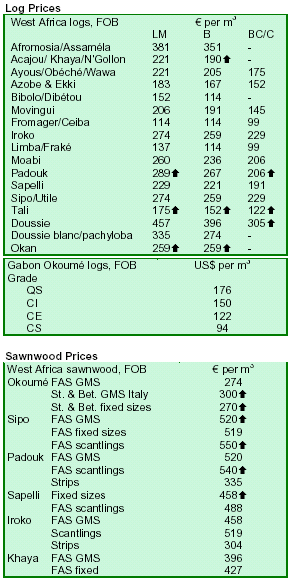
2. GHANA
More export permits issued in first quarter of 2006
A total of 1,879 export permits were issued to exporters during the first quarter of 2006 (see table) for the
shipment of various wood products through Takoradi and Tema (Ghana¡¯s two main seaports) as well as overland to
neighbouring countries. This is 9% up from the first quarter in 2005. The increase could be attributed to the
removal of the National Reconstruction Levy by the Minister of Finance and Economic Planning, improving
producers¡¯ profit margins. Lumber (both KD and AD)
accounted for 61% of the export permit applications, showing the growing demand for the exports of AD and
KD lumber as compared to secondary processed wood products (spwp) like furniture parts and profile boards.
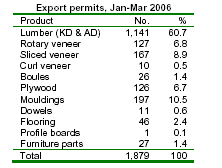
The increased number of permits issued in the quarter
under review involved increased export value in spite of a decrease in volume. The export volume declined 21%
to 72,865 m3 while the value rose 26% to euro43.7 million compared with the same quarter last year. A total of 68
export permits (3.6% of the total issued permits) were granted to eight individual companies which exported
9,864 m3 of plywood and lumber products by road to Burkina Faso, Mali, Nigeria, Niger, Togo and Benin,
worth euro2.8 million.
In the period under review, 12 permits on levied species were issued in Takoradi port for the shipment of of AD
selected species. These included odum, mixed redwood, African mahogany (khaya), wawa and Edinam, which
accounted for 39%, 20%, 18%, 15% and 8%, respectively of the total levy of .16.2 million.
TTID issues more permits for non-traditional exports
The number of export permits for non-traditional timber products such as secondary processed wood products
(spwp) is expected to increase following a decision by CEPS (Customs, Excise and Preventive Service). The
decision requires export permits to be issued by the Timber Industry Development Division of the Forestry
Commission (TIDD) before approval is granted for spwp
exports. CEPS officials at all the ports and stations nationwide have been informed of the decision.
Previously, companies were able to ship spwp by just using the ¡¡ãNon-Traditional Export¡¡À Form from the
Ghana Export Promotion Council (GEPC). Non-traditional exports include products such as
plywood, veneer, furniture and other processed timber/wood products.
Portal poised to expand exports of solid wood doors
The Managing Director of Portal Wood Processing Company Ltd., Mr. Wellington Baiden, informed that the
company was well positioned to capture the African market of solid doors. He said that with the completion
of expansion works, Portal had the capacity to process 300 KD solid doors daily for the export market. The
company has a forest and plantation programme to ensure wood sustainability, particularly from
fast-growing plantations. Mr Baiden said that for every door sold, the company plants a tree in replacement.
Portal sees a boom in construction and an increase in the
demand for quality construction products.
During the 31st Council Meeting of the African Union of Architects, Portal displayed a range of KD solid doors of
varied sizes, shapes and colours. Some of the products included doorframes, single and double doors, kitchen
cabinet doors, glass doors, wardrobe doors, architraves and T&T. Portal is the only factory of its kind in the
West African sub-region which produces solid and designed doors for various woodwork requirements.
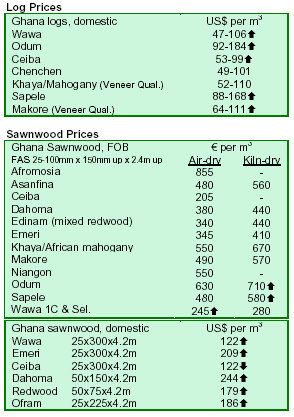
3.
MALAYSIA
Malaysia hosted ITTO meeting on ramin
The ITTO Expert Meeting on the Effective Implementation of the Inclusion of ramin (Gonystylus
spp.) in Appendix II of CITES was held in Kuala Lumpur from 16 to 19 May 2006. Some 50 experts from
range states, transit and importing countries, trade, industry and civil society participated in the meeting and
made recommendations on how to ensure that the inclusion of the species in CITES would continue to be effectively implemented.
The inclusion of ramin in CITES Appendix II took effect on 12 January 2005. Prior to this, the species was
included in CITES Appendix III on 6 April 2001. On both occasions, the inclusions were made at the genus
level and with annotation #1, covering all parts and derivatives except seeds, spores, pollen, seedling or
tissues cultures and cut flowers of artificially propagated plants.
Trade and investment mission heads for China
The Malaysian Minister of International Trade and Industry (MITI), Datuk Seri Rafidah Aziz, is leading a
trade and investment mission to Beijing, Shanghai and Hong Kong S.A.R. on 24-31 May. The mission
comprises 49 private sector representatives from 34 companies and officials from MITI, Malaysia Industrial
Development Authority (MIDA) and Malaysia External Trade Development Corporation (MATRADE). The
main objectives of the mission are to promote the export of products and services from Malaysia, strengthen
business networking and establish collaborative initiatives and joint ventures between the Malaysian and
Chinese private sectors. In 2005, China was Malaysia's fourth largest trading partner, export destination and
import source. Logs and sawn timber accounted for almost 6% of the exports to China.
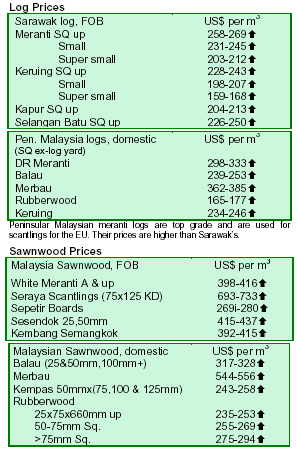
4.
INDONESIA
Acacia Mangium plantation gains GFTN membership
The International Finance Corporation's Program for Eastern Indonesia SME Assistance (IFC-PENSA) has
successfully assisted Inhutani II, a Kalimantan-based state-owned enterprise, in gaining membership of the
WWF's Global Forest and Trade Network (GFTN), marking an endorsement of Inhutani's Acacia Mangium
plantation on Pulau Laut, South Kalimantan. The development is considered a step forward for Indonesia's furniture industry.
The 50,000 ha plantation owned by PT Inhutani II is the first acacia plantation in Indonesia to join the GFTN
(SLJ II concession of dipterocarp forests is also a member, see TTM 11:5). The network endorses responsible forestry
enterprises and links them with international buyers seeking sustainably produced timber products. Nusa
Hijau is the local name for the Indonesian arm of the
GFTN.
Increased supplies of sustainably grown timber such as acacia are expected to help create jobs in Indonesia's
ailing furniture industry, which is dependent on teak wood and natural forest species. The quantity and the
quality of teak available in Indonesia are declining as the species takes 25 years to reach a size suitable for use in
furniture. Acacia grows across the country and can reach
furniture size in 8-10 years. Because of its faster growing cycle, it is said to be much cheaper to produce.
The Inhutani II plantation had been preparing for membership for two years. Inhutani II must show a
commitment to achieving FSC certification within five years. IFC has been also assisting smaller furniture
manufacturers by providing training on how to dry acacia timber properly, stain the wood and create products for
the international market. Ten manufacturers displayed their acacia furniture designs at the International
Furniture Fair in Singapore in March 2006, notably KWAS Furniture, an acacia furniture producer from
Yogyakarta. Local manufacturers as well as furniture retailer IKEA have expressed interest in Inhutani II's
products.
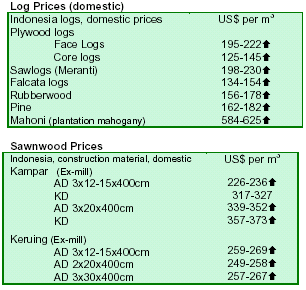
5.
MYANMAR
Prices stable ahead of late May tenders
There were no significant changes in the teak, pyinkado and gurjan market. The sealed tender and tender sales
will be held on 26 and 29 May. Higher prices seemed to have been the cause of the quite market for
pyinkado. However, logs with larger girths (7¡¯ or more) can attract buyers. New arrivals of gurjan logs continued to be sold steadily.
Four companies trade logs in Thai border
There are four companies Century Dragon, Lucre Wood, Tin Myint Yi and Star Sapphire trading logs in the border
with Thailand, where these are processed. Century Dragon has already shipped out some volume of teak and
padauk logs. The remaining companies are still arranging to ship out their logs.
Hoppus
ton=1.8m3; All grades, except SG-3, assorted and domestic, are length 8' x
girth 5' and up. SG-3 is girth 4' and up while assorted
and domestic are girth 4' and up. SG-3 grade is higher than SG-4 but with
lower girth and price.
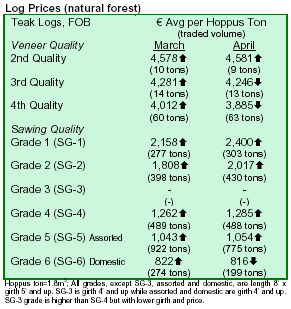

6. PAPUA
NEW GUINEA
Surge in PNG log exports in February
Log exports from PNG (excluding plantation logs) amounted to 163,766 m3 in March and surged to 194,783
m3 in April 2006. Total log exports (excluding plantation) amounted to 1,349,545 m3 in the year to
April 2006. Saw/veneer grades accounted for 90% of the total. Main log export species were taun,
malas, bintangor and terminalia. China took 79% of all log exports, followed by Japan (7.5%), Vietnam (6%) and
Korea (4%). Of the saw/veneer log grades, China imported 89%, Japan 5.3%, Korea 2.6% and Vietnam
1.3%. For plantation species, kamarere remained the main export species primarily to the markets of Vietnam,
Japan, China and Korea.
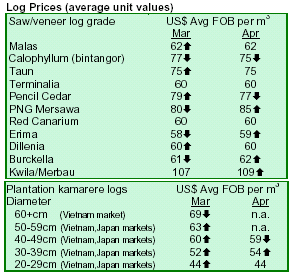
7.
BRAZIL
Domestic prices hold as US dollar slump continues
Prices of wood products in Brazilian reais were largely unchanged in late May. Conversely, prices in US dollars
rose 3.8% during the period due to the continued appreciation of the Brazilian currency against the US
dollar. However, the trend reversed briefly in the last week of May as the reais depreciated sharply.
Exports of solid wood suffer further decline
Exports of solid wood products declined 6.9% to $308.4 million in April 2006, compared with the same period in
2005 due to reductions in exports of plywood, furniture and tropical
sawnwood. Exports of tropical sawnwood continued to fall, dropping 30% to 117,200 m3 (down 24%
to $40 million) in April 2006. Exports of pine plywood also fell 7% to 132,700 m3 (down -3.3% to $35.6 million).
Exports of tropical plywood plummeted 44.4% to 35,500 m3 (down 33% to $16 million) while exports of wood furniture
slipped 16.6% to $65 million. In contrast, exports of pine sawnwood increased 24.3% to $29.3 million (up 14.3% to
136,600 m3) in April 2006.
Wood preservation vital in major economic sectors
A recent study from the Brazilian Institute of Applied Economic Research (IPEA) revealed that wood
preservation is vital in at least four major economic sectors, namely agri-business, railroad,
electricity and civil construction. In the agri-business sector, there are growing opportunities for trade in treated wood products
used for fencing. Moreover, the performance and durability of agricultural equipments made from treated
wood, such as poles for electricity and phone lines, can
generate competitiveness in this sector. In the railroad sector, the opportunity is associated with modernisation
of the national infrastructure, particularly in main railroad projects currently under implementation: the
New TransNordestina and North-South railroads. These projects will provide opportunities for almost 3.3 million
of treated wood pieces.
With regards to the electric sector, Brazil is heavily investing in new power plants to expand its energy
capacity (over $4 billion up to 2008), bringing up opportunities for increasing demand for treated wood
poles. Meanwhile, in the civil construction sector, new credit lines for middle-class housing and the reduction of
the Industrialized Product Tax (IPI) for a basket of 26 retail products, including materials for civil construction,
are expanding wood product demand throughout the
country. The study points out opportunities of increasing demand for wood components and parts such as
structural wood, beams, doors and treated wood frames.
Rising costs prompt imports of sawnwood
Furniture producers of Santa Catarina, Southern Brazil, are trying new strategies to overcome the rising costs resulting
from the continuous appreciation of the Brazilian reais. In addition to the 20% reduction in labour force, some
companies have created new product lines at 5% above average prices. Other producers are importing various raw
materials, including wood products. Some companies started importing sawnwood from Argentina and hardware
from China, at prices 15% and 30% lower, respectively. However, one of the limitations faced by small and
medium-sized companies is the inability to import large volumes. Importing in groups is complicated as
specifications (measures and designs) vary from one company to another.
Brazil regulates certification of wood packaging
The Ministry of Agriculture (MAPA) has approved a normative instruction on wood certification of packaging
used in the trade of products in line with international norms. Normative Instruction No. 7 internalises FAO's
guidelines of the International Norm of Phytosanitary Measures (NIMF 15) and sets the requirements for
treatment and phytosanitary certification of wood material for packaging, framework and merchandise wrapping of any
nature, used in imports or exports. The main objective of this action is to prevent the introduction and dissemination
of foreign forest pests among countries.
MAPA estimates that the Normative Instruction will impact all economic sectors, with increasing consumption of wood
materials, and not only imports and exports linked to the agri-business. According to MAPA, about 50 workshops
were carried out in order to discuss the subject with various economic sectors.
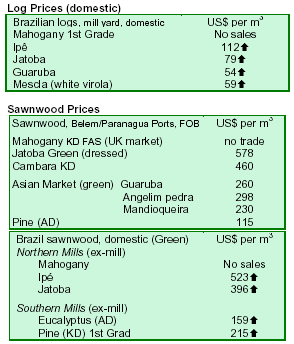
8. PERU
US dollar weakens against Peruvian sol
The uncertainty surrounding the outcome of the forthcoming presidential elections on 4 June has
contributed to exchange rate volatility. The Peruvian sol has fluctuated between 3.40 and 3.27 per US dollar
during the last two months. However, the US dollar fell sharply to 3.20 sol in the second half of May. The
Minister of Economy and some analysts think that the decline was due to greater exports and foreign exchange
earnings circulating in the domestic market.
Nationalization talks raise concern in wood sector
The winds of nationalization blowing in South America have raised concerns in the wood industry. The reason
behind this is the possibility that the forest concession process can be revised by the new government. Some
analysts in the wood sector indicate that if the Peruvian forest concessions are
" nationalized" , it would be
translated into economic losses of over $20 millions just in the first three months.
Mahogany sawnwood prices scale new record highs
Prices for mahogany sawnwood S&B KD 16% for the US market that had reached record highs of $1,600 per
m3 in the last quarter of 2005, soared sharply to a new all time high of $1,800-$1,850 per m3 in May. The surge
was reportedly due to higher operative and extraction costs. Furthermore, delay in the issuance of CITES
certificates for mahogany product exports by INRENA is putting added pressure on prices. INRENA is currently
delivering CITES certificates 20 business days after
receiving the exporter's documentation, compared with only six business days previously.
Prompex study aims at improving wood supply
The Peruvian Commission for the Promotion of Exports (Prompex) has been analyzing the domestic supply of
wood to improve the flow of raw material to sawmills. According to previous studies, wood products had a high
demand but adequate supply remained a major problem. The log deficit of sawmills had been estimated at
741,000 m3 for one mill¡¯s shift (8 hours) and 1.73 million m3 for 1.5 shifts (12 hours) in 2004 while the deficit for
plymills was estimated at 43,000 m3 and 182,000 m3 for one and 1.5 shifts, respectively. The results of the current
study will facilitate the identification of available species and volumes from forest concessions as the basis for
elaborating a proposal for the improvement of the forest concession system.
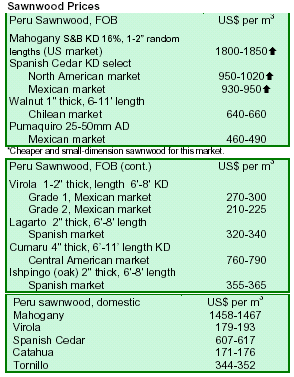
9. BOLIVIA
Santa Cruz's wood exports continue rising trend
Wood exports continued their rising trend in the first four months of 2006 in Santa Cruz, Bolivia's main wood
industry region. In spite of the installation of the new government, Santa Cruz's wood exports grew 20% to
almost $14 million, compare with the same period in 2005. This increase was mainly led by furniture and
sawnwood exports attributed to a 30% rise in sawnwood's average prices, although furniture average prices declined 35%.
In other news, Bolivia named Lic. Jose A. Martinez as the new interim Forestry Superintendent on 9 May 2006, replacing Mr. Francisco Kempff.
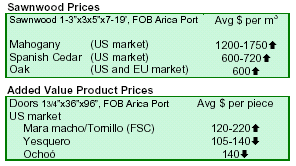
10. Guatemala
Guatemala exports one-third of teak production
Since 2002, Guatemala has produced 51,725 m3 of teak and exported 37% of its production in diverse products
that included plywood, logs, charcoal, sawnwood and others. The balance was traded in the local market. In the
first four months of 2006, 6,100 m3 of teak were harvested while 53% of the production was exported.

11.
Guyana
Capacity building for over 25 forest communities
The Guyana Forestry Commission (GFC) has strengthened its capability to play a more active role in
promoting and supporting community forestry for hinterland communities that have access to forestry
resources. The GFC recently received support from the UNDP to support capacity building and training for over
25 community-based forestry organizations. The GFC hopes that this would place communities in a better
position to manage their resources in a sustainable manner and also contribute significantly to their livelihood development.
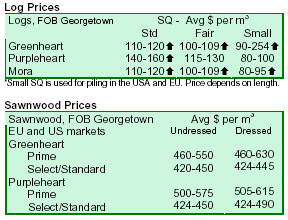
|